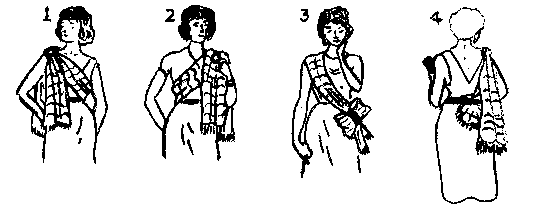The proper method of wearing the tartan sash for ladies
INCORPORATING A TARTAN SASH in your ladies’ highland dress outfit is a great way to show off your Murray clan heritage and leaves you looking your best for that special event. The sash is a versatile product and there are multiple different ways to wear it. If you are interested in how to style your sash traditionally or looking for inspiration for a more contemporary look, this guide shows the different ways you can wear your sash to fit your style. The origins of the sash remain unclear, but it is believed to have derived from the tradition of women wearing an arisaid – a popular item of regional dress in the 18th century for women in the Scottish Highlands. This garment was made from two lengths of tartan fabric, wrapped around the waist and draped over the shoulders, to provide comfort and warmth. The cloth could then be fastened together at the front with a pin or brooch. A sash is a lightweight scarf, usually longer than a regular scarf which is draped around the torso. Sashes are typically made in the tartan of the wearer’s family clan and can be secured with a pin or brooch. They are considered a decorative feature to enhance your evening look and is often worn with traditional Scottish dress at a Ceilidh, Burns Supper or other formal event. It is also a great way for brides and the wedding party to add some tartan into their formalwear. Traditionally, sashes are made from wool, although today can be produced in many different fabrics. The following information was taken from careful study of old portraits, prints, and traditional practice, and appear with the authoritative approval of the Lord Lyon, King Of Arms:-

1. Style worn by Clan women. The sash is worn over the right shoulder across the breast and is secured by a pin or small brooch on the right shoulder.
2. Style worn by wives of Clan Chiefs and by wives of Colonels of Scottish Regiments. The sash which may be fuller in size is worn over the left shoulder and secured with a brooch on the left shoulder.
3. Style worn by ladies who have married out of their clans but who still wish to use their original clan tartan: The sash is usually longer than style 1, and it is worn over the right shoulder secured there with a pin and fastened in a large bow on the left hip.
4. Style worn by country dancers or where any lady desires to keep the front of the dress clear of the sash. Perhaps to wear a sash of some chivalric order or any orders and decorations. The style is similar to the belted plaid and is really a small arisaid. It is buttoned on at the back of the waist, or is held by a small belt, and is secured at the right shoulder by a pin or small brooch, so that the ends fall backwards from the right shoulder and swing at the back of the right. Note: Members of the Royal Scottish Country Dance Society were granted permission by Her Majesty, Queen Elizabeth II to wear their sashes on the left shoulder. This is an honour bestowed upon the Society because she was Patron.
The Royal Caledonian Ball
THE ROYAL CALEDONIAN BALL dates to the 1840s when George, Duke of Atholl, and his wife, Anne, wanted to entertain their Scottish friends residing in London. The Royal Caledonian Ball has been held annually since 1849, except during the Bower War; World War I and World War II; following the death of King Edward VII on 6th May 1910, and during the COVID-19 pandemic in 2020, and it is the oldest charity ball in the world. The Royal Caledonian Ball's dress code stipulates that male attendees wear Highland evening dress, evening tails with white tie, or mess dress. Women should wear floor-length evening dress or mess dress; tartan sashes are encouraged. Originally, men wore full evening tartan while women were dressed in white, with a tartan sash. Indeed, it was the only socially acceptable opportunity to wear full tartan outside Scotland. The event is known for its Scottish country dancing and it is traditional for guests at the ball to dance every reel. Traditionally, the Duke and Duchess of Atholl started the dancing and the Duke usually brought with him his own private army, the Atholl Highlanders, to play and to pipe onto the floor everyone taking part in the ceremonial set reel before performing an eightsome reel, a dance of Atholl origin introduced in 1890.



Centre: Queen Elizabeth (The Queen Mother) welcomed at Grovenor House by The 10th Duke of Atholl (centre) in 1959